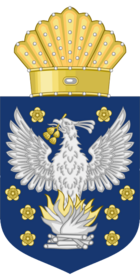Shindan dynasty: Difference between revisions
No edit summary |
mNo edit summary |
||
| Line 29: | Line 29: | ||
|event5 = | |event5 = | ||
|date_event5 = | |date_event5 = | ||
|event_pre = | |event_pre = | ||
|date_pre = | |date_pre = | ||
|event_post = Declaration of the [[Empire of Zhenia]] | |event_post = Declaration of the [[Empire of Zhenia]] | ||
|date_post = June 4, 1868 | |date_post = June 4, 1868 | ||
Revision as of 23:45, 6 March 2020
This article is incomplete because it is pending further input from participants, or it is a work-in-progress by one author. Please comment on this article's talk page to share your input, comments and questions. Note: To contribute to this article, you may need to seek help from the author(s) of this page. |
Shindan dynasty 대신단국(大新檀國) | |||||||||
|---|---|---|---|---|---|---|---|---|---|
| 1298–1866 | |||||||||
| Anthem: "To the east and onwards" (1848-1868) | |||||||||
| Map of the Shindan dynasty, c. 1800. Map of the Shindan dynasty, c. 1800. | |||||||||
| Capital | Sanggyeong | ||||||||
| Common languages | Zhenian | ||||||||
| Religion | Zhenian Wuism | ||||||||
| Government | Absolute Monarchy | ||||||||
| King | |||||||||
• 1298-1331 | Taejo | ||||||||
• 1844-1889 | Seongjo | ||||||||
| History | |||||||||
• Established | October 30 1298 | ||||||||
| 1436-1489 | |||||||||
| 1630-1633 | |||||||||
| 1846-1847 | |||||||||
| 1851-1868 | |||||||||
• Reorganization into the Empire of Shindan | November 7 1866 | ||||||||
• Declaration of the Empire of Zhenia | June 4, 1868 | ||||||||
| Currency | Shindanese coins, paper bills | ||||||||
| |||||||||
| |||||||||
Part of a series on the |
|---|
| History of Zhenia |
 |
| Timeline |
The Shindan dynasty (Zhenian: 신단국, literally translated as "New Danguk", formally 대신단국/大新檀國), was a historical nation-state and kingdom that existed mostly in the Danguk Peninsula portion of modern-day Zhenia from 1298 to 1866, until it was reorganized into the Empire of Shindan, after which it finally became the Empire of Zhenia in 1868. It was founded after a dynastic revolution by Seok Juwon that overthrew Gaewon in modern-day Hansan, after which the nation was retitled in tribute to the primordial Dan dynasty. The Shindan dynasty remains the longest-surviving single entity in the Danguk peninsula apart from the Zhen dynasty.
From early on, the Shindan dynasty adopted Sambong thought, an ideology consisting of pragmatic legalism and the teachings of Kim Dojin, as its ruling principle, encouraging the absorption of Sambong thought and legalist ideals in Shindanese society and attempting internal political stability. The dynasty led a series of expeditions to the east, linking the dynasty into the extensive global trade network and establishing a series of colonies and trading posts across the world, including modern-day Kapuku and Florencia. Experiencing almost two centuries of economic and military prosperity afterwards, the dynasty entered the Shindanese Golden Age, which lasted well into the 16th century. However, the dynasty was significantly weakened by a series of military conflicts with the Greater Wu, after which it became a tributary state to the Greater Wu and was stripped of its former glory. The dynasty met an era of resurgence with the 19th century, with a series of reforms by King Jeongjo and his successor King Seongjo, who transformed the nation into an industrialized power by the 1840s.
